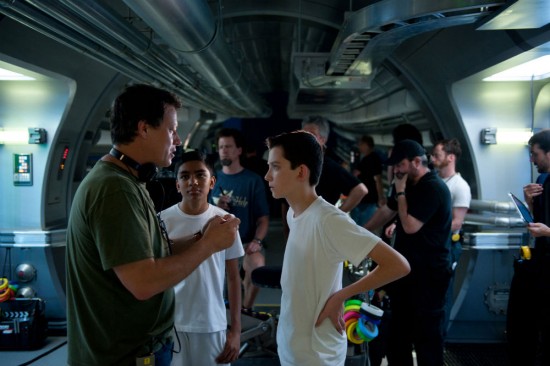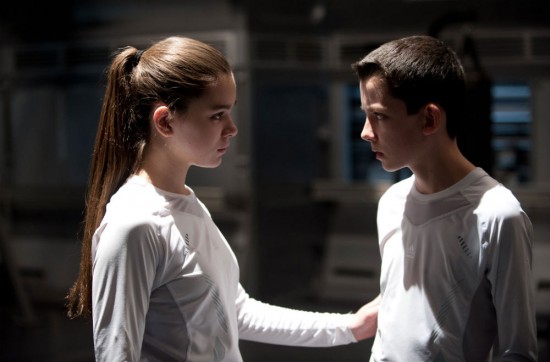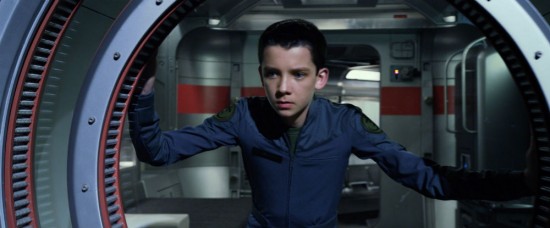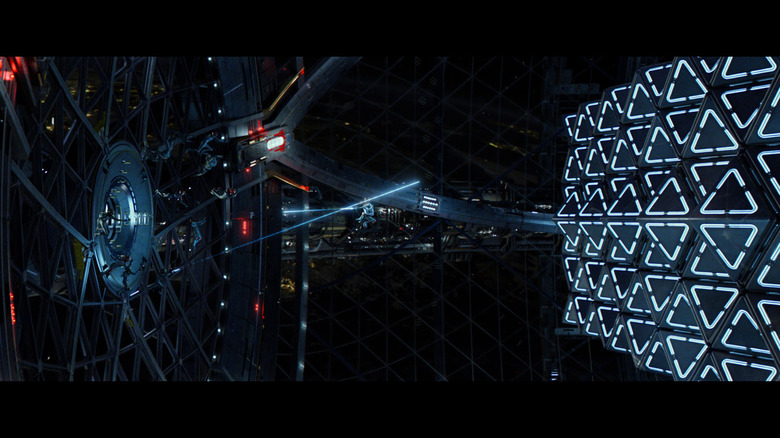'Ender's Game' Set Visit: 30 Things We Learned About The Film And Battle Room [Video Blog]
When meeting Harrison Ford isn't the highlight of your day, that's a day for the ages. On the New Orleans set of Ender's Game, the man who played Han Solo, Indiana Jones and Rick Deckard was there and I shook his hand. Incredibly, though, that moment was topped when I realized director Gavin Hood had figured out a way to make kids fly in zero gravity.
In Orson Scott Card's sci-fi masterpiece Ender's Game, a young boy named Ender leaves Earth and enters Battle School to train for an inevitable attack from an alien race called the Formics. They train in a zero gravity space called the Battle Room where dozens of pre-teen boys and girls zip and float around in formation, blasting each other with guns. It's here that Ender learns to be a great leader and where the action of Ender's Game hinges.
What I found out on May 17, 2012 – the 59th day of a 70 day shoot – was that Hood not only pulled off these sequences, he's pulled them off with the actual actors and practical effects. A whole new way of basically puppeteering actors to look like they're in zero gravity had to be invented to do this, but with the polish of digital effects Hood and his team have realized the dreams of every single Ender's Game out there.
After the jump, read our set visit which includes a video blog and 30 things I learned on the set of Ender's Game about the production origins, the Battle Room and more.
First up, here's a video blog about the whole experience featuring Jeremy Kirk from First Showing. (Note: The video is pretty messed up for the first 90 seconds or so but the audio is fine.)
Production origins
1. Ender's Game might be the largest independently produced film of all time – After years of development hell, it basically took fans of the book – such as producers Alex Kurtzman and Roberto Orci – to grow up and gain Hollywood influence to finally get the film made made. They took a CG reel made at Digital Domain to Cannes 2011 hoping to raise a budget through foreign sales (the rumored budget is $110 million). They were successful, ultimately giving the production the freedom it needed. "The big advantage [of doing it independently] is the genuine passion for the book the producers all have," Hood said. (He's among the producers.) "They're taking a massive risk because they believe in the story and themes and the idea."2. If the film hadn't been produced independently, many sacrifices would have been made – Before deciding on producing the film on their own, the team brought the project to many major studios. Most of the executives wanted major changes, such as Ender being older so a more bankable actor could play him. Hood said one studio executive asked "Why can't Ender just kick the aliens' ass at the end? That's what these movies do?" When they walked out of the meeting, Producer Linda McDonough immediately said "Well we aren't going to do it here, they don't get it at all."3. Real age wasn't possible – In the original book, Ender is 6 years old and the story spans about 7 years. While casting, Hood and his team saw kids of all ages and realized six-year-olds simply couldn't pull off the intense drama. They decided on casting mostly pre-teens and young teenagers (star Asa Butterfield was 14 when production started) because they felt it was important to keep the characters a few years shy of puberty to maintain innocence and the basic themes of the story.4. The story has been consolidated and streamlined – Though the book is pretty dense story-wise, it was decided early on this film is Ender's story. Siblings Peter and Valentine, so important in the book, are only seen through him. "Orson was incredibly ahead of his time when he wrote the book in the mid 80s," Hood explained. "He was basically writing about what we do today on blogs and Facebook, and now it's kind of known. If there's something that was 'less exciting' it was [Peter and Valentine's story of writing on the blogs]." Plus the entire story now takes place over the course of one year.5. Gavin Hood started from scratch – Though several filmmakers (such as Wolfgang Petersen) took a shot at Ender's Game in the past, Hood decided not to look at any of their previous work. Some of the producers did, though, and they admitted to pushing for a few things to be kept. They wouldn't say what. 6. Orson Scott Card was very involved – Hood and his producers had to personally pitch the book's author to get the rights when they lapsed at Warner Bros. He embraced their views on the book and not only agreed to let them make the movie, he provided feedback, visited the set and even did a cameo as the voice of the pilot transporting kids to battle school.7. Bean is given more to do – The character of Bean, played by Aramis Knight, is so important, Card wrote a companion piece to Ender's Game called Ender's Shadow, which takes place at the same time though his eyes. This movie is Ender's, though, so we won't see those events. Because the character is so important later in the series, however, his role was slightly bolstered to draw attention to the character.8. If movie is a success, they'd love to do Ender's Shadow as a TV show. – This is according to producer Linda McDonough.9. There was briefly talk of doing two movies simultaneously – Bean's story is so good, producers thought about shooting it alongside Ender's Game. The money just wasn't there.10. 3D was considered but decided against – Even though it's a big budget movie, every dollar was important, so filming or converting to 3D was simply too expensive. Plus, Hood felt the lack of 3D would up the human emotion. "There were two ways to shoot this movie," Hood said. "It's either big spectacle, wide lenses or it's long detailed lenses that examine what the heck this boy is going through. Those kind of shots are not good in 3D. There was something very pure and honest about shooting in 2D."
6. Orson Scott Card was very involved – Hood and his producers had to personally pitch the book's author to get the rights when they lapsed at Warner Bros. He embraced their views on the book and not only agreed to let them make the movie, he provided feedback, visited the set and even did a cameo as the voice of the pilot transporting kids to battle school.7. Bean is given more to do – The character of Bean, played by Aramis Knight, is so important, Card wrote a companion piece to Ender's Game called Ender's Shadow, which takes place at the same time though his eyes. This movie is Ender's, though, so we won't see those events. Because the character is so important later in the series, however, his role was slightly bolstered to draw attention to the character.8. If movie is a success, they'd love to do Ender's Shadow as a TV show. – This is according to producer Linda McDonough.9. There was briefly talk of doing two movies simultaneously – Bean's story is so good, producers thought about shooting it alongside Ender's Game. The money just wasn't there.10. 3D was considered but decided against – Even though it's a big budget movie, every dollar was important, so filming or converting to 3D was simply too expensive. Plus, Hood felt the lack of 3D would up the human emotion. "There were two ways to shoot this movie," Hood said. "It's either big spectacle, wide lenses or it's long detailed lenses that examine what the heck this boy is going through. Those kind of shots are not good in 3D. There was something very pure and honest about shooting in 2D."
The Battle Room
11. Everyone knows the Battle Room is the most highly anticipated location in the movie – Within the first ten minutes of our set visit, producer Linda McDonough said way before filming started they knew zero gravity in the Battle Room was the thing all the fans were curious about. Extra-special attention was paid to it.12. Five and four - There will be about five scenes in the Battle Room and it took about 4 weeks to shoot them all.13. Everything was on a budget, except the zero gravity – Whatever the cost, producers knew the zero gravity battle scenes had to be done right. Stunt coordinator Garrett Warren said he was never given any kind of restrictions in developing the zero gravity tech because everyone knew the movie hinged on it.14. All different options were looked at – Hood and Warren looked at all kinds of different ways to capture the zero gravity including, but not limited to, actually filming in real zero gravity. They investigated more mundane solutions such as computer graphics and motion-capture, but eventually decided on elaborate practical effects.15. A performance of Le Reve at the Wynn in Las Vegas was a major inspiration – Warren saw an actress in the lead being graceful on the wires and knew what they had to accomplish was possible.16. Lots and lots of wire work – To accomplish the correct look of zero gravity, the movement had to be smooth and fluid. (The example given was to imagine your whole body has been shot with Novocaine.) The team used extensive wire work to accomplish this. The main system was an XYZ Gantry system measuring about 80 x 50 feet. Shaped like an "H," the actors were wired up like a camera moving above a football game. "Once you got over the uncomfortable factor, it just became a lot of fun," said Oscar-nominee Hailee Steinfeld, who plays Petra. 17. Tension is high – The scenes were very tense. Literally. To make sure the actors didn't look like they were bouncing or dropping when they jumped into the zero gravity Battle Room, the tension on the wires had to be incredibly tight.18. Two rigs were invented for this movie – In addition to the Gantry system, two other rigs were used to capture zero gravity scenes, both invented specifically for this movie. First was a lollipop arm, which is like a counter-balance offering a full range of motion. (Picture a hangman game, but you're attached at the waist.) The second innovation was a "people crane." It's a contraption, sort of like the lollipop arm, but put on air pucks so that the effects is like you are floating around in the air.19. Cirque du Soleil was brought in to help – All the actors trained for a month with individual Cirque members so they could do the wire performances themselves. Some of the kids even trained in martial arts to help with motion.[EDITOR'S NOTE: Despite being told the above information on the set, we were contacted by Cirque's Corporate PR Manager who said "Maybe they were former technicians or employees but Cirque du Soleil, as a company, was not at all involved in this movie production."]20. Harrison Ford has his own harness – The legendary actor, who plays Colonial Graff in the film, had to do some zero gravity flying too. To do so he brought his own harness that he used on the Indiana Jones films.21. Most of Battle Room is green screen - Even with a big budget for these scenes, they couldn't build a full room. They just made a small section and will fill in the rest with green screen.22. Three stars for dozens – Inside the battle room are dozens of massive floating obstacles called "stars", for the combatants to hide behind. However, since just a small part of the room was built, they only built three real "stars." Each weighed 13,000 lbs.
17. Tension is high – The scenes were very tense. Literally. To make sure the actors didn't look like they were bouncing or dropping when they jumped into the zero gravity Battle Room, the tension on the wires had to be incredibly tight.18. Two rigs were invented for this movie – In addition to the Gantry system, two other rigs were used to capture zero gravity scenes, both invented specifically for this movie. First was a lollipop arm, which is like a counter-balance offering a full range of motion. (Picture a hangman game, but you're attached at the waist.) The second innovation was a "people crane." It's a contraption, sort of like the lollipop arm, but put on air pucks so that the effects is like you are floating around in the air.19. Cirque du Soleil was brought in to help – All the actors trained for a month with individual Cirque members so they could do the wire performances themselves. Some of the kids even trained in martial arts to help with motion.[EDITOR'S NOTE: Despite being told the above information on the set, we were contacted by Cirque's Corporate PR Manager who said "Maybe they were former technicians or employees but Cirque du Soleil, as a company, was not at all involved in this movie production."]20. Harrison Ford has his own harness – The legendary actor, who plays Colonial Graff in the film, had to do some zero gravity flying too. To do so he brought his own harness that he used on the Indiana Jones films.21. Most of Battle Room is green screen - Even with a big budget for these scenes, they couldn't build a full room. They just made a small section and will fill in the rest with green screen.22. Three stars for dozens – Inside the battle room are dozens of massive floating obstacles called "stars", for the combatants to hide behind. However, since just a small part of the room was built, they only built three real "stars." Each weighed 13,000 lbs. 23. Digital faces, just in case – All the kids had their faces scanned in case they had to be replaced digitally in the Battle Room. But it was just a precaution because Hood tried to capture all the movement in camera.24. Unique design shape – The Battle Room itself is a glass ball with a view of space, set in the center of Battle School. The school is shaped like the Discovery One in 2001 blended with a teardrop. [Seen here]25. One Battle Room – In the book, Card says there are multiple Battle Rooms at the school but Hood and others felt that was slightly unrealistic. They decided to make it just one, but make it ultra-important. "What high school has more than one football field?" he asked.26. Lots of camera movement – Throughout the film, Hood wanted the camera very rigid and almost militaristic. However, once it's in the Battle Room, it's all over the place. Floating and flying, just like the kids. "The idea was formal, disciplined composition until the kids jump out into the Battle Room," Hood said. "Now you fly and the camera moves. 'Freedom at last.' And then you're forced back into the dormitory with the rows of beds."27. Ender's Game owes a lot to Avatar and Paradise Lost – Stunt coordinator Garrett Warren and his wire innovations were essential to Ender's Game. However, if it wasn't for the near decade he spent working with wires on Avatar, or the fact a project he was working on, Alex Proyas' Paradise Lost, was cancelled, he never would have worked on the project.
23. Digital faces, just in case – All the kids had their faces scanned in case they had to be replaced digitally in the Battle Room. But it was just a precaution because Hood tried to capture all the movement in camera.24. Unique design shape – The Battle Room itself is a glass ball with a view of space, set in the center of Battle School. The school is shaped like the Discovery One in 2001 blended with a teardrop. [Seen here]25. One Battle Room – In the book, Card says there are multiple Battle Rooms at the school but Hood and others felt that was slightly unrealistic. They decided to make it just one, but make it ultra-important. "What high school has more than one football field?" he asked.26. Lots of camera movement – Throughout the film, Hood wanted the camera very rigid and almost militaristic. However, once it's in the Battle Room, it's all over the place. Floating and flying, just like the kids. "The idea was formal, disciplined composition until the kids jump out into the Battle Room," Hood said. "Now you fly and the camera moves. 'Freedom at last.' And then you're forced back into the dormitory with the rows of beds."27. Ender's Game owes a lot to Avatar and Paradise Lost – Stunt coordinator Garrett Warren and his wire innovations were essential to Ender's Game. However, if it wasn't for the near decade he spent working with wires on Avatar, or the fact a project he was working on, Alex Proyas' Paradise Lost, was cancelled, he never would have worked on the project.
Filming
28. There was an order to things – A large percentage of the movie was shot sequentially because there are really only three locations. Hood said if you can do it that way, why wouldn't you?29. Scene One – Gavin Hood shoots about one take per line of dialogue. When were there, we saw two scenes shot around Ender's arrival at Battle School. First, was Ender and Sergeant Dap (played by Nonso Anozie) walking down some stairs. "I didn't expect to find you here, Sergeant," says Ender. "Someone's gotta keep you in check, sir," said Dap. Most notable is Asa's American accent which is very cold and calculated. Plus, even a simple shot like this has tons of movement in the background from extras. It's a massive movie. 30. Harrison Ford is a pro – The next scene we saw filmed took about seven takes all together. It's of Ford's character explaining the Formic planet of Eros to Ender. "It's not very hospitable is it?" He nails the line in the first take but Hood wants it again. It lacked energy, he said. The second take was slightly better. On the third take Hood keeps it rolling and he does the line three times in the same take. The camera move is a push-in with Ender looking out a window onto the planet. When Hood backs up the camera to do a master take, Ford screws up his line. Hood starts to correct him when Ford snaps back "Yes yes yes, I've only said it 300 times!" He composes himself, and nails the line perfectly two more times. That's a wrap.Ender's Game hits theaters November 1.
30. Harrison Ford is a pro – The next scene we saw filmed took about seven takes all together. It's of Ford's character explaining the Formic planet of Eros to Ender. "It's not very hospitable is it?" He nails the line in the first take but Hood wants it again. It lacked energy, he said. The second take was slightly better. On the third take Hood keeps it rolling and he does the line three times in the same take. The camera move is a push-in with Ender looking out a window onto the planet. When Hood backs up the camera to do a master take, Ford screws up his line. Hood starts to correct him when Ford snaps back "Yes yes yes, I've only said it 300 times!" He composes himself, and nails the line perfectly two more times. That's a wrap.Ender's Game hits theaters November 1.

